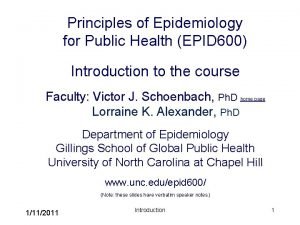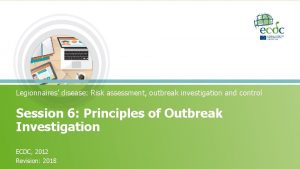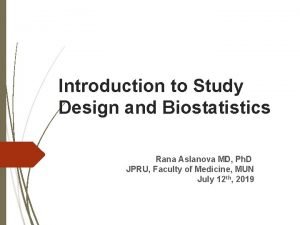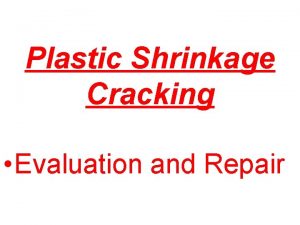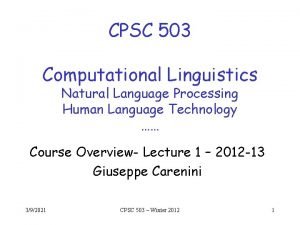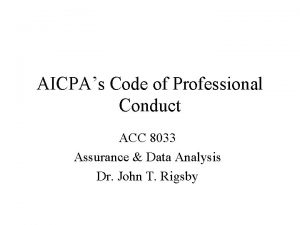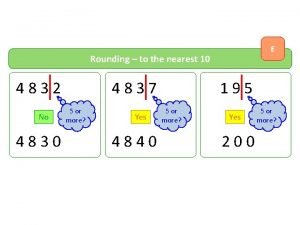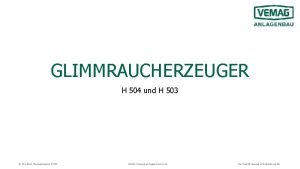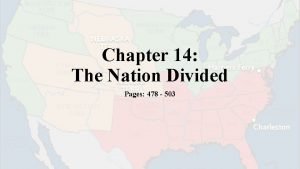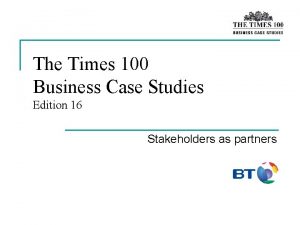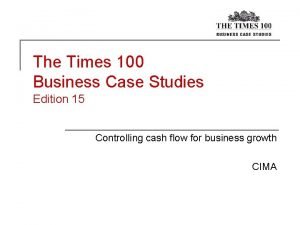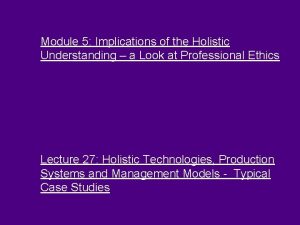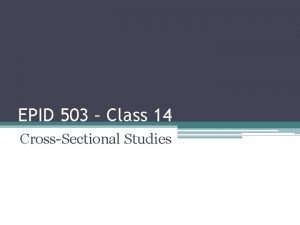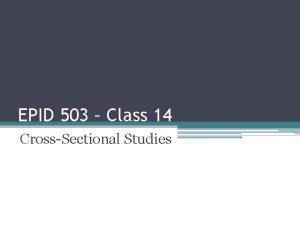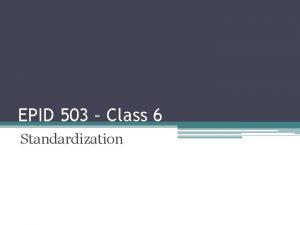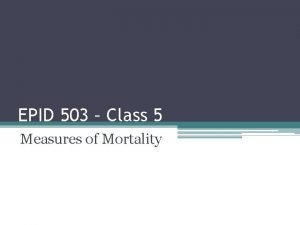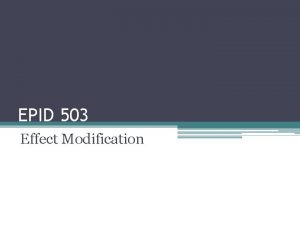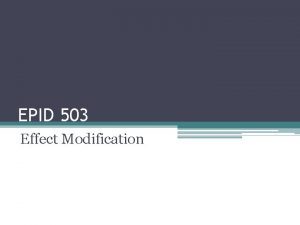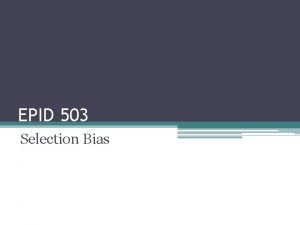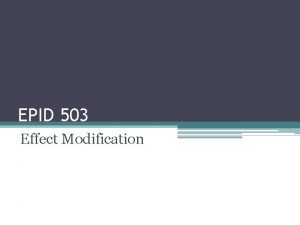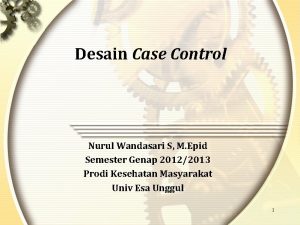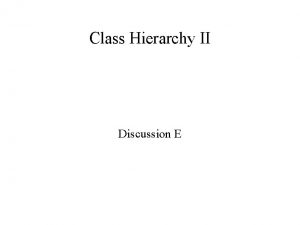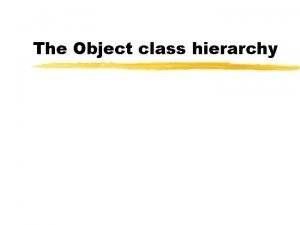EPID 503 Class 13 Case Control Studies Hierarchy





















- Slides: 21

EPID 503 – Class 13 Case Control Studies

Hierarchy of Study Designs • Randomized Controlled Trials Establish Causality Gold standard for establishing causality • Cohort Studies • Case Control Studies • Cross-sectional Studies • Ecological Studies Generate Hypotheses Good place to start investigating a research question

Goal of Epidemiological Investigation • Determine if there is a causal relationship between exposure (i. e. risk factor) and disease ▫ Are persons who are exposed more likely to get disease than those who are unexposed?

RCT and Cohort Study Design Disease Study Population Randomized or Self Selected Exposed Not exposed No disease Disease No disease Time ▫ Start with exposed and unexposed and follow over time to see who develops disease ▫ Participants must be “at risk” of developing outcome

5 Strengths & Limitations Strengths • Maintain temporal sequence • Can estimate incidence (risk or rate) of disease • Can assess rare exposures • Assess multiple outcomes (and exposures in cohort studies) Limitations • Expensive • Poor design for rare diseases • Long-term follow-up may be needed • Can be issues with self -selection of exposures in cohort studies

Goal of Epidemiological Investigation • Determine if there is a causal relationship between exposure (i. e. risk factor) and disease ▫ Are persons who are exposed more likely to get disease than those who are unexposed? (RCT and cohort studies) ▫ Are persons with disease were more likely to be exposed than persons without disease? (Case-control study)

Case-Control Study Design Exposed Cases (i. e. Diseased) Controls (i. e. No Disease) Unexposed Exposed Unexposed ▫ Start with cases and controls and compare exposure distributions in the two ▫ Controls to represent the exposure in the population that gave rise to the cases

Strengths & Limitations: Case-Control Study • Advantages ▫ Efficient for rare diseases ▫ Can evaluate multiple exposures ▫ Less costly and time consuming than cohort • Disadvantages ▫ Focused on one outcome ▫ Inefficient for rare exposures ▫ Issues with exposure assessment – recall bias, temporality ▫ Selection of controls challenging

Why is Control Selection So Hard? • Controls to reflect distribution of exposure in population that gave rise to cases • Options include friends, family, hospital controls, random digit dialing, drivers licenses, etc. • Must be sure not to select group based on exposure!!!!

An Example Scenario: What Might be the Issue? Scientific Question of Interest: Is diabetic shock related to alcohol consumption?

• Cases: Hospitalized patients with new diagnosis of lung cancer in 20 hospitals in London and surrounding area • Controls: Hospitalized patients in same hospital without lung cancer but other cancers and diseases • What’s the issue here? How could we have gotten better controls?

How Do We Analyze Data from a Case. Control Study?

Structure of Data from Case Control Exposed No Cases a Controls b c d What is missing and why did I remove them?

Case-Control Does Not Capture Prevalence or Incidence Directly Exposed No Total Case a Control b Total a+b c d c+d a+c b+d a+b+c+d Ratio between cases and controls set by investigator – no longer reflects distribution in population.

Disease (Cases) No Disease (Controls) Odds of exposure Exposed a b a/c Not exposed c d b/d a+c b+d Total Odds of exposure among cases = Odds = Ratio Odds of exposure among controls = a a+c c a+c 15 Probability of exposure Probability of no exposure b b+d d b+d Odds ratio= ad/bc

16 Odds Ratio in Matched Case Control Study Control (+) Control (-) Case (+) a b Case (-) c d Matched Odds Ratio = b/c

17 Interpretations OR = 1 No association between exposure and disease OR > 1 Disease associated with increased odds of exposure (e. g. , OR=2) �E. g. ‘The odds of exposure are two times higher in the cases than in the controls. . . ’ OR < 1 Disease is associated with lower odds of exposure (e. g. , OR = 0. 6) �E. g. ‘The odds of exposure are 0. 6 times lower in the cases than the controls or flipping the exposure, controls had a 1/0. 6 = 1. 67 higher odds of exposure than the cases…’

18 A Note About the Odds Ratio Can be estimated in a cohort study or RCT as odds of disease among exposed vs. unexposed (works out to be the same formula) but. . . Not preferred measure for those studies since we prefer to know about risk and odds ratio will always overestimate RR unless disease is rare

Odds Ratio Will Estimate Risk Ratio if Disease is Rare RR a a+ b OR a b c c+d c d D D- Total E a b a+b E- c d c+d b+d a+b+c +d Total a+c Because ‘a+b’ is ~b when disease is rare

20 Comparing the OR and RR Zhang, J. et al. JAMA 1998; 280: 1690 -169

OR an Overestimation of RR when Disease is Common P(disease)exp 1 -P(disease)exp P(disease)unexp 1 -P(disease)unexp P(disease)exp 1 -P(disease)unexp x = P(disease)unexp 1 -P(disease)exp If P(disease) ~ 0 then OR = RR If P(disease)exp > P(disease)unexp (ie. RR>1) then OR > RR If P(disease)exp < P(disease)unexp (i. e. RR< 1) then OR < RR
 Epid 600 unc
Epid 600 unc Advantages and disadvantages of case control studies
Advantages and disadvantages of case control studies Case series
Case series Aci 503
Aci 503 Cpsc 503
Cpsc 503 Nacr-503
Nacr-503 What is immediate family considered
What is immediate family considered Humiseal 503
Humiseal 503 Unit 503
Unit 503 4832 rounded to the nearest ten
4832 rounded to the nearest ten Heamop
Heamop 683x4
683x4 H 503
H 503 503 divided by 3
503 divided by 3 Best case worst case average case
Best case worst case average case Paradigm shift from women studies to gender studies
Paradigm shift from women studies to gender studies Advantages of case studies in psychology
Advantages of case studies in psychology Times 100 business case studies
Times 100 business case studies The times 100 business case studies
The times 100 business case studies Holistic technology in human values
Holistic technology in human values Gdpr case studies
Gdpr case studies Gcse geography manchester case study
Gcse geography manchester case study
